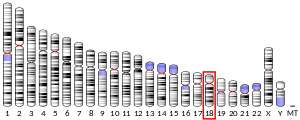CNDP1
Beta-Ala-His dipeptidase is an enzyme that in humans is encoded by the CNDP1 gene.[5][6]
This gene encodes a member of the M20 metalloprotease family. The encoded protein is specifically expressed in the brain, is a homodimeric dipeptidase which was identified as human carnosinase. This gene contains trinucleotide (CTG) repeat length polymorphism in the coding region.[6]
The metabolic disorder Carnosinemia may be caused by mutations in this gene.
References
- 1 2 3 GRCh38: Ensembl release 89: ENSG00000150656 - Ensembl, May 2017
- 1 2 3 GRCm38: Ensembl release 89: ENSMUSG00000056162 - Ensembl, May 2017
- ↑ "Human PubMed Reference:".
- ↑ "Mouse PubMed Reference:".
- ↑ Teufel M, Saudek V, Ledig JP, Bernhardt A, Boularand S, Carreau A, Cairns NJ, Carter C, Cowley DJ, Duverger D, Ganzhorn AJ, Guenet C, Heintzelmann B, Laucher V, Sauvage C, Smirnova T (Feb 2003). "Sequence identification and characterization of human carnosinase and a closely related non-specific dipeptidase". J Biol Chem. 278 (8): 6521–31. doi:10.1074/jbc.M209764200. PMID 12473676.
- 1 2 "Entrez Gene: CNDP1 carnosine dipeptidase 1 (metallopeptidase M20 family)".
Further reading
- Lenney JF, Peppers SC, Kucera CM, Sjaastad O (1983). "Homocarnosinosis: lack of serum carnosinase is the defect probably responsible for elevated brain and CSF homocarnosine". Clin. Chim. Acta. 132 (2): 157–65. doi:10.1016/0009-8981(83)90243-7. PMID 6616870.
- Lenney JF, George RP, Weiss AM, et al. (1982). "Human serum carnosinase: characterization, distinction from cellular carnosinase, and activation by cadmium". Clin. Chim. Acta. 123 (3): 221–31. doi:10.1016/0009-8981(82)90166-8. PMID 7116644.
- Bonaldo MF, Lennon G, Soares MB (1997). "Normalization and subtraction: two approaches to facilitate gene discovery". Genome Res. 6 (9): 791–806. doi:10.1101/gr.6.9.791. PMID 8889548.
- Harrington JJ, Sherf B, Rundlett S, et al. (2001). "Creation of genome-wide protein expression libraries using random activation of gene expression". Nat. Biotechnol. 19 (5): 440–5. doi:10.1038/88107. PMID 11329013.
- Strausberg RL, Feingold EA, Grouse LH, et al. (2003). "Generation and initial analysis of more than 15,000 full-length human and mouse cDNA sequences". Proc. Natl. Acad. Sci. U.S.A. 99 (26): 16899–903. doi:10.1073/pnas.242603899. PMC 139241. PMID 12477932.
- Clark HF, Gurney AL, Abaya E, et al. (2003). "The Secreted Protein Discovery Initiative (SPDI), a Large-Scale Effort to Identify Novel Human Secreted and Transmembrane Proteins: A Bioinformatics Assessment". Genome Res. 13 (10): 2265–70. doi:10.1101/gr.1293003. PMC 403697. PMID 12975309.
- Ghose S, Weickert CS, Colvin SM, et al. (2004). "Glutamate carboxypeptidase II gene expression in the human frontal and temporal lobe in schizophrenia". Neuropsychopharmacology. 29 (1): 117–25. doi:10.1038/sj.npp.1300304. PMID 14560319.
- Gerhard DS, Wagner L, Feingold EA, et al. (2004). "The Status, Quality, and Expansion of the NIH Full-Length cDNA Project: The Mammalian Gene Collection (MGC)". Genome Res. 14 (10B): 2121–7. doi:10.1101/gr.2596504. PMC 528928. PMID 15489334.
- Janssen B, Hohenadel D, Brinkkoetter P, et al. (2005). "Carnosine as a protective factor in diabetic nephropathy: association with a leucine repeat of the carnosinase gene CNDP1". Diabetes. 54 (8): 2320–7. doi:10.2337/diabetes.54.8.2320. PMID 16046297.
- Rual JF, Venkatesan K, Hao T, et al. (2005). "Towards a proteome-scale map of the human protein-protein interaction network". Nature. 437 (7062): 1173–8. doi:10.1038/nature04209. PMID 16189514.
- Liu T, Qian WJ, Gritsenko MA, et al. (2006). "Human Plasma N-Glycoproteome Analysis by Immunoaffinity Subtraction, Hydrazide Chemistry, and Mass Spectrometry". J. Proteome Res. 4 (6): 2070–80. doi:10.1021/pr0502065. PMC 1850943. PMID 16335952.
- Zschocke J, Nebel A, Wicks K, et al. (2007). "Allelic variation in the CNDP1 gene and its lack of association with longevity and coronary heart disease". Mech. Ageing Dev. 127 (11): 817–20. doi:10.1016/j.mad.2006.08.002. PMID 16965804.
- Zhang P, Chan DW, Zhu Y, et al. (2007). "Identification of carboxypeptidase of glutamate like-B as a candidate suppressor in cell growth and metastasis in human hepatocellular carcinoma". Clin. Cancer Res. 12 (22): 6617–25. doi:10.1158/1078-0432.CCR-06-1307. PMID 17121880.
- Freedman BI, Hicks PJ, Sale MM, et al. (2007). "A leucine repeat in the carnosinase gene CNDP1 is associated with diabetic end-stage renal disease in European Americans". Nephrol. Dial. Transplant. 22 (4): 1131–5. doi:10.1093/ndt/gfl717. PMID 17205963.
- Riedl E, Koeppel H, Brinkkoetter P, et al. (2007). "A CTG polymorphism in the CNDP1 gene determines the secretion of serum carnosinase in Cos-7 transfected cells". Diabetes. 56 (9): 2410–3. doi:10.2337/db07-0128. PMID 17601991.
- Sauerhöfer S, Yuan G, Braun GS, et al. (2007). "L-carnosine, a substrate of carnosinase-1, influences glucose metabolism". Diabetes. 56 (10): 2425–32. doi:10.2337/db07-0177. PMID 17601992.
External links
- Human CNDP1 genome location and CNDP1 gene details page in the UCSC Genome Browser.
This article is issued from
Wikipedia.
The text is licensed under Creative Commons - Attribution - Sharealike.
Additional terms may apply for the media files.




